Those involved with the station in the early to mid-2000s depict halcyon days. Station event producer (1998-2003) Robyn Walker: “It was a magic era. With the growth of appreciation of New Zealand music, as well as dance, dub, and electronic music, it felt like the station was at the centre of the universe.”

Robyn "Rock Girl" Walker, event producer at Radio Active, 1998-2003. - Photo by Sarah Hunter
Miles Buckingham adds, “During the flush days of the early 2000s we’d put on a whole week of gigs during New Zealand music month.”
Music journalist Martyn Pepperell recalls, “It was amazing seeing what Active could do with events like One Love and Handle the Jandal. When I reflect now, I realise how important these were to the local scene that was unfolding. They were a platform that helped make Fat Freddy’s and TrinityRoots and all the rest what they are now.”
One Love became a phenomenon unto itself. For the first few years Active’s Waitangi Day celebration had been an enjoyable but modest affair by the beach. Then in 2001 the event moved to The Dell in Wellington’s Botanic Gardens, and around 5000 people attended. This was a vast increase on audience size from previous years. Walker – who produced One Love during this era – remembers: “We were really surprised when that many people turned up to the Botanic Gardens for TrinityRoots … little did we know what was coming the following year.”
Following The Dell event, Colyn Oliver-Clyne was out walking through the hills of Wellington. “I stumbled across the Wellington Velodrome, and next thing you know One Love had moved there. From 2002 onwards it became one of the biggest Waitangi Day celebrations in the country.” The 2002 event – headlined by Fat Freddy’s Drop and The Black Seeds – drew a crowd of over 12,000 people. By 2006 that number had grown to nearly 15,000. “Those events were huge for Wellington,” says Pepperell. “They were a collective effort that came at the right time.”
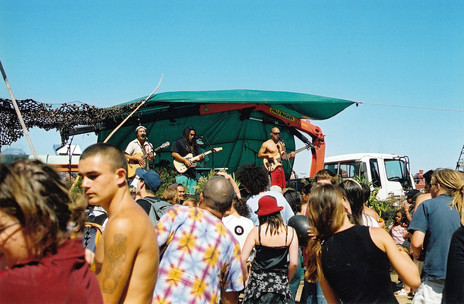
One Love, Wellington Velodrome, 2003. - Radio Active collection
The event got to a point where it was difficult to sustain. Phil Reed remembers, “I was publicist when the event became huge. 10,000 plus people rammed into a space not much bigger than two rugby fields. They were beautiful sunny days, and the event featured on the 6pm news for mostly the right reasons … though of course they can’t resist a shot of a white middle-class man with dreads passing a fatty around. We put on such a great Waitangi Day over those years. But an event that big quickly gets noticed by the council. Then it’s goodbye chilly-bin full of beers and hello traffic management plans, temporary fences, licensing, and security … all at a huge cost to the station. So, we had to start charging … but it turns out nobody in Wellington likes paying even just a few dollars for an event that has been free for years.”
Meanwhile back at the studios, Active was enjoying the fruits of binary. This was the era of digital coming to the fore. Though a computer had joined the production studio’s long-serving eight-track tape recorder a few years earlier, the only editing software on it was a demo version of Cool Edit 96, which allowed a maximum session length of 28 seconds. In 2000 the station procured the newly released Pro Tools Digi 001, the first Pro Tools system accessible outside of high-end recording studios. This allowed the station to produce high-quality advertisements and station imaging, independent of the Marmalade Audio studio. Active production staff celebrated in analogue, building a fit-for-purpose recording booth against all odds.
Just a few years beforehand, Active had been one of the few radio stations still playing content from tape carts. Advertisements and local music demos had to be individually assigned a cart, which were then then loaded and played in real time by the DJ. But now advertisements and station IDs played off an on-air studio computer, while multiple unreleased music tracks were loaded onto a single mini disc. MP3 playlists replaced the five-disc CD player that broadcast (often the sound of one disc skipping for hours) when the last DJ had left for the night.

Radio Active subscription card, late 80s.
In 2001 the station rebranded its Subcard as the ActiveCard, which was sponsored by Saturn (now Vodafone) for two years. The Subcard was launched in 1989 as an income stream for the station, a database of Active listeners, and a bridge between the station’s audience and its advertisers. The Subcard offered benefits for a yearly fee, including discounts at nominated retailers, discounted entry to Active-affiliated events, and the ability to win on-air prizes. In 1996, an undergraduate student named Stephen Upton volunteered to oversee the service. “Subcard Steve” then significantly revamped the system, dropping the subscription from $25 a year to $1. He also arranged more discounts and incentives for cardholders, and the ability to pay for a card via SMS, which at the time was innovative. “Dropping the price prioritised data over immediate dollars long before user information was valued like it is today,” says Upton.
Alongside Gibbons, other staff from this era would go on to work for the station long-term. Up until this point, staff turnover had been high, a remnant of the campus radio operational model. Carl Jackson was programme director from 2000 to 2009, before Miles Buckingham took on the role from 2011 to 2017 (with Scott Nicolson sandwiched in between). Liam Ryan was breakfast show host from mid-2000 to mid-2010, before Paul “Redbird Jnr” Shelley took on the role from mid-2011 to 2018. Sandwiched – or perhaps breakfast bapped – in the middle was Reed, who had produced and co-hosted Ryan’s show from 2007 before taking on the show in the interim.
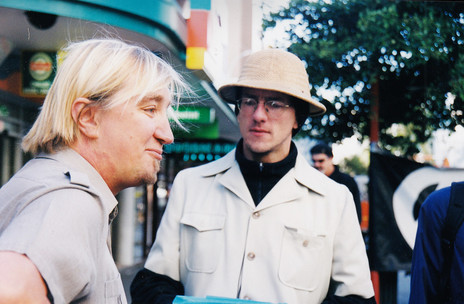
Miles Buckingham and Liam Ryan during a Radio Active outside broadcast on Lambton Quay. - Radio Active collection
Ryan – like a lot of the people in this story – had a history with the station before taking on Breakfast. He discovered Active in the mid-1980s. “I started listening for the hip hop and it grew from there. Later me and my mate Leon Surynt headed up there, and that’s how I got involved. I progressed through the ranks … listener, fanboy, requester, volunteer DJ, programme director, overseas for a bit, and then breakfast host for 10 years.
“I got to interview Frankie Knuckles, and I cross-examined the finance minister about 100 times and held it down. I also got to work with some great people and play some wonderful music, encourage others to love great music, and I met a lot of inspiring people including the listeners.”
Ryan’s news presenter for a period was a young Samantha Hayes. Buckingham remembers, “I once saw Liam ‘explain’ to Samantha Hayes how to read the news, which she then did. He was rendered speechless.”
The station’s second paid show began sometime in the mid-2000s. Previously hosted by a different volunteer DJ each day, the 10am to 1pm slot was renamed Amplifier. Hosted first by Rhysface, Redbird Jnr then took over before moving to Breakfast.
In 2011 Rodrigo Pantoja began hosting the show, a role he maintains to this day. Pantoja – or Don Luchito as he is known on-air – has ongoing enthusiasm for the role. “I still pinch myself daily that I probably have the coolest job, in the coolest radio station in the coolest capital of the coolest country in the world.” Active also experimented with a permanent weekday lunchtime host, with Clair Urbahn hosting C-60 in 2002, which was later renamed Sam60 when hosted by Hayes in 2003.
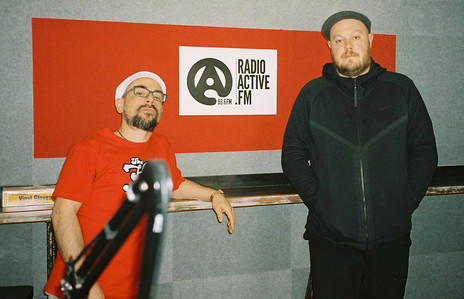
Don Luchito and Martyn Pepperell. - Martyn Pepperell collection
A defining aspect of Active in the 2000s was the success and impact of its public events, though by 2011 these were all but over. The Handle the Jandal music video competition had become a thriving affair, attracting multiple high-quality entries, and filling The Embassy Theatre for an annual awards night before it ended in 2009. Two years later Gibbons announced that One Love had been cancelled, explaining that the station could not risk a financial loss. In the January 2011 Dominion Post article, he explained that the event had never made big profits, even after an entry fee was introduced. The article also revealed that the station faced one-off costs of up to $100,000 that year, due to having to change frequencies. Gibbons then promised that One Love would return to the Velodrome the following year, though it never did. Buckingham remembers, “The year we pulled the plug it ended up raining on Waitangi Day.”
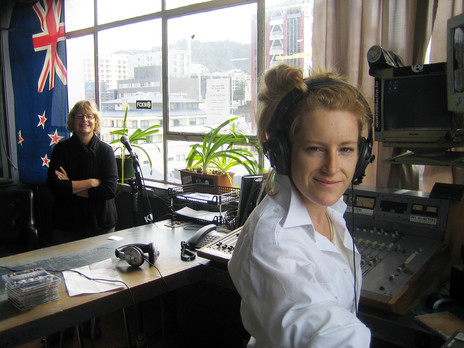
Claire Urbahn broadcasting a Mother's Day special with her mum (left), c. 2007. - Radio Active collection
From there Radio Active’s fortunes began to shift. First, the change of frequency from 89FM to 88.6FM was less than ideal. In Wellington, 89FM had been associated with Radio Active since 1982, and had long been used in station branding and imaging. There was also a significant cost attached to changing the branding and imaging, as well as the technology and logistics required to migrate. Also – somewhat subjectively – 88.6 just wasn’t as good a number. There are mixed accounts as to whether this change could have been avoided, as well as how gracefully the station managed the process, but the bottom line is Radio Spectrum Management needed to create equal spacing of 0.8 MHz between radio stations, and so worked with all radio broadcasting licence holders to do so. The station then rebranded to RadioActive.fm.
The following year Active was forced to leave its Victoria Street premises owing to issues with the new owner of the building. In 2011 Frank Wong had purchased the building from the liquidator of one of Terry Serepisos’ companies. Unfortunately, the station did not reconcile with Wong’s idea of a desirable tenant. Matters were not helped when a station staffer added a speech bubble with some naughty words inside it to an “out of order” sign on a urinal, which the new owners interpreted as an affront. Tensions grew, culminating with the station’s lease not being renewed. Active then moved to a street-front premises at 75 Ghuznee Street.
The timing of the move was not great. By now the media landscape had significantly changed, but Active’s approach to being a media outlet had not. The station was financially struggling again and infrastructure was deteriorating. The station’s transmitters had not been properly maintained, leading to one of them failing. Relationships with several external stakeholders had significantly deteriorated, affecting wider perceptions of the station. Staffing was now skeletal. The new premises could not be set up as intended, as the acoustics had not been evaluated. The building windows were not fit for purpose, and the tenants upstairs had not been considered. This led to the on-air studio being set up in the kitchen. Following the move to Ghuznee St, Gibbons was increasingly absent.
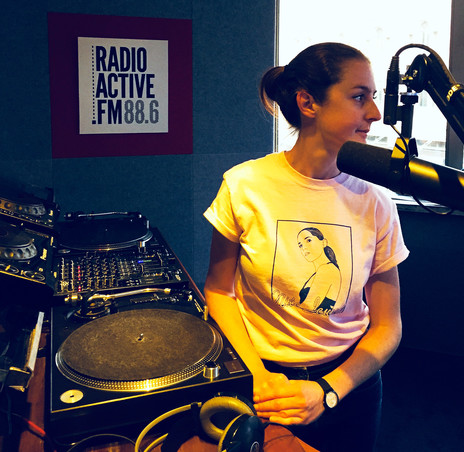
Jen Kyle in the studio, 2018. - Radio Active collection
Despite this, the station continued to broadcast. Paid staff worked hard to maintain the station, as did several volunteers. Though Jen Kyle’s official title was on-air producer, her dedication to the station saw her performing a much wider variety of day-to-day roles as needed. David “Budd” Pugsley had been employed as Active’s IT technician, but soon proved to be – as Reed describes – “one of those Swiss Army Knife guys that are essential in the running of entities like Active”. He continues, “If the power went out at the transmitter, Budd would go up the hill and sort it out. When one of our obsolete computers died again, Budd revived it. The dude just knew how to fix stuff and boy did we need him. Also, he’s one of the loveliest guys you’ll ever meet.”
Pugsley worked with Buckingham on a new music playlisting and programming system, making it possible to get new music on rotate within minutes of receiving it. The system proved itself when Martyn Pepperell alerted Buckingham to a brand new tune by emerging artist Lorde, called ‘Royals’.
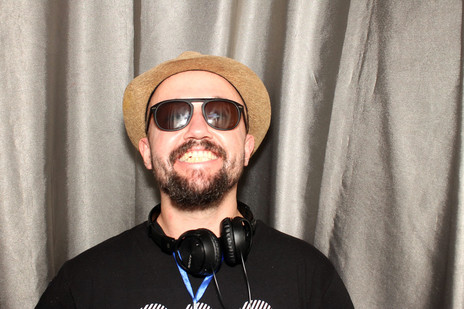
David "Budd" Pugsley, Newtown Festival 2018. - Radio Active collection
In February 2017 a Stuff headline read “Days numbered for Wellington’s Radio Active”. In the article, company director Nicholas Bagnall explained that – although Active had never been a money-making enterprise – over the past few years he had been propping up the station with his own finances. Bagnall then issued a plea, stating that unless someone stepped in to “take the reins of the money-losing station by March 15, the dial would go quiet at 88.6FM”. In the same article, Gibbons clarified that the station was not going to close, stating, “all we are doing is winding up the limited liability company”.
The configuration of said company had changed over the years. Where Radio Active Ltd had been incorporated by 19 people who had each equally invested, there were now two majority shareholders. One was Bagnall, who had long been a present and proactive board member, and the other was Gibbons, the station’s now long-serving general manager. Both held six of the 30 station shares, or a 20% stake each. This was the maximum allowed as set out in the Constitution of Radio Active Ltd (1995). In 2002 Gibbons was allocated two shares, acquiring four more in 2006. These acquisitions reduced the number of shareholders by five. Each share held equalled one vote at shareholder meetings, and meetings required a quorum of 50% of the company’s voting capital. Clause 12 of the constitution stated that a special meeting could be held if the general manager of Active requested shareholders to vote on a decision to dismiss him or her.
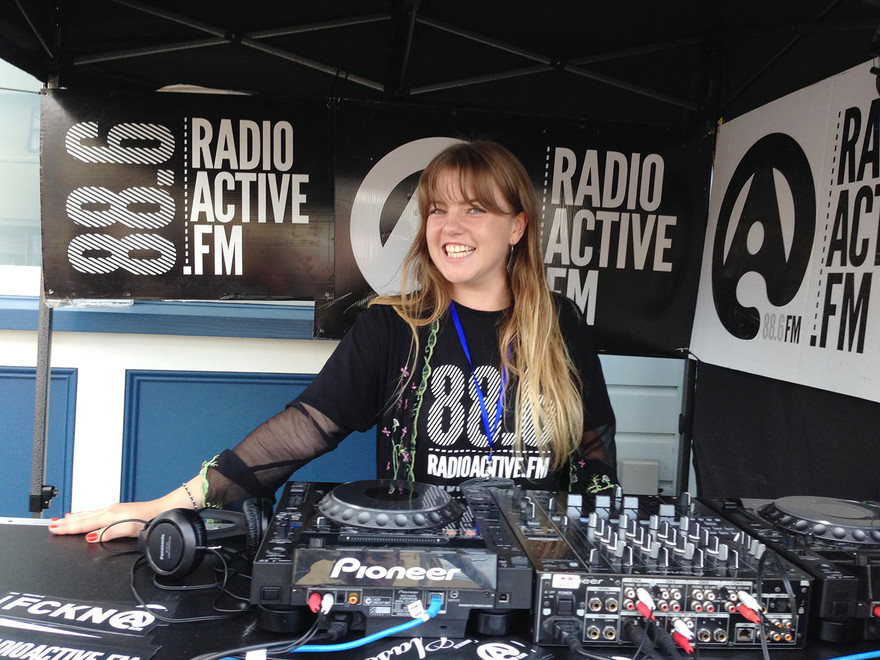
Harri Robinson broadcasting from Newtown Festival, 2018. - Radio Active collection
Just over a month after Bagnall spoke to Stuff, a new headline read “Cuba St cartel steps in to save Wellington station Radio Active”. The article explained “The 88.6FM frequency was set to go silent on Friday but has had a reprieve thanks to a generous raft of backers, including bars and businesses around Cuba St, Wellington Mayor Justin Lester, and musicians Fat Freddy's Drop.” It further stated, “a charitable trust has been formed to run Radio Active subject to regulatory consents and shareholder approval.” In the article, trust chairman Ross Steele enthused that the trust had been extremely heartened by the huge number of people and organisations expressing goodwill and support.
Before the establishment of the trust, Gibbons had stepped away from the station. Via a prepared statement Steele explains: “Prior to 2017 Radio Active had been running at a loss, and had been financially supported by its chairman Nicholas Bagnall. The constitution of the station was not amenable to bringing in much needed fresh capital. Nicholas was not prepared to continue to pour money into it, and so he went public with the hope of finding someone like myself to rally support for the station. We made a fresh start with a completely new governance structure. As a newly established trust we gained financial support from some of the station’s traditional core advertising partners, mainly those in the hospitality industry. We also tapped into the enthusiasm of Active’s listeners, raising much needed funds by way of a Givealittle campaign.”
The Givealittle campaign, which aimed to raise $88,600, ended at $91,010. A benefit gig organised by Loop’s Mikee Tucker further bolstered the fundraising drive.
Though Gibbons tenure did not end ideally, he did successfully navigate Radio Active for a period. Buckingham states, “He saw the dollar and how to squeeze in and grab it.” Walker contends, “I’m sad that Dave couldn’t lift the station, because he cared. Unfortunately, he didn’t maintain positive connections, so in the end the station struggled. But then the media landscape was also changing, as was how music was being delivered.”
Torlesse is pragmatic: “We needed some stability when he started, kind of like a Roosevelt looking after the place until it’s really fixed. But there’s always the danger of someone settling in and staying too long.”
Oliver-Clyne is glad to see the station return to being run by a collective. “Active is a community radio station that ended up focusing too much on revenue at the cost of community engagement. It put a value on all publicity on-air. This alienated the station from its core contributors, the creative community. Sometimes it is better to provide free exposure to those that define what Radio Active is, than to take money and provide a platform for those that do not.”
Gibbons did not respond to requests to contribute to this article.

David 'Budd' Pugsley', Todd O'Hagen, two volunteers and Pete May moving the desk to Radio Active's new Taranaki St location, 2017. O'Hagen built the desk from wood salvaged from Athletic Park. - Radio Active collection
Following a successful fundraising campaign, Active moved to its current location on Taranaki Street. New equipment was purchased, including an Airence broadcasting desk. The station now has a dedicated performance room, which is used for live-to-air and recording sessions.
The Session’s Pete and Andy were invaluable to the set up and build of the new studios, as they were at 75 Ghuznee St, and 175 Victoria St. Pepperell describes the new studio as luxurious. “The overall space isn’t as homely as the earlier ones, but the studio is excellent. It’s beautifully laid out, organised, and decorated.”
Roy Torlesse, the station’s longest serving announcer, agrees. “It’s trim and luxurious, like a Maserati. It’s a super car. The old Holden is gone. There are computers doing all sorts of stuff, and there’s no misbehaving anymore. We’d just say ‘well that slot is being filled by the computer until we find someone new.’”
Station staffing has had a refresh too. Jen Kyle is now station manager, while Harri Robinson is the programme director. The station’s breakfast host, Maggie Tweedie, is in her own words, “the first and youngest solo female weekday Breakfast host in New Zealand.”
Kyle, who began at the station as a volunteer in 2010, is seen by many as an asset to the station. Former Saturday Drive host and station sales rep Felix Five observes, “She pretty much gave everything to that station through some very rough years. Her often silent hand was a huge part of the transition from the descent years to the current rebirth.” Tweedie agrees: “I’ve loved seeing her graduate to station manager. She has a remarkable sense of leadership.”
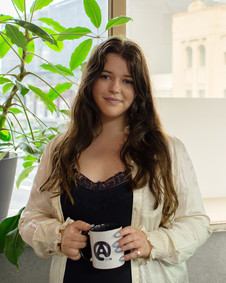
Maggie Tweedie, Radio Active Breakfast host, Taranaki St studio, 2022.
Commentary about the current state of the station is favourable. Pepperell observes, “It might not feel like the sound of the city in the same way it did 15 years ago, but they’ve got a super on-to-it team that’s mostly made up of women, excellent studios, and a great DJ roster. Active is again engaging with the community at events. From Newtown Festival to a street fair or other local events, it feels like Active is out there again. There was a stretch where that just wasn't the case at all.”
Reed notes, “At its heart is a longstanding community of diehard fans, and as they’ve got older, the station has too. It’s easy to say that the station is stuck in its ways, and no longer striving to be the vanguard of culture. But I think what the world needs now is connection and curation, rather than the tyranny of the algorithm. Active is now back on its feet, and Active provides these community connections”.
Kyle continues to reinvigorate the station, also reconnecting it with the wider community. “The station helps others, and others help the station. It’s a give-and-take from both sides. Our DJs come from different scenes, and here they cross over into other scenes. We support as many community causes as we can, giving them voices on air, listing events on our community notices, and sponsoring community events when we can. We’re involved with Fringe NZ, Cuba Dupa, Kaibosh, and City Gallery Open Late. Recently we sponsored the Wellington Pride Parade, before teaming up with the NZ Aids Foundation to do a live broadcast from a parade float. That was a lot of fun. The station has also been a vocal supporter of pay parity for midwives, changing street and statue names to te reo Māori, and promoting safety and wellbeing initiatives at local venues. We’re also doing more in the digital realm now; increasing video content on the website, interacting more with listeners online, and releasing more on-demand content. We’ve also rebuilt relationships with our sister stations.”

Roy Torlesse, host of Roy's Time Machine, Ghuznee St studios, 2016. - Radio Active collection
Radio Active has been broadcasting in Wellington since 1976, thanks to a succession of dedicated staff, volunteers, organisers, and listeners. For Steve Hogg – aka The Rabid Dog – being involved with Active was formative. “It was just the rock and roll moment we all hope to live in our lives. To me it was like one big party that went for four years, but I regret nothing. It was the greatest stepping stone too. My career since, I owe all of that to Active.”
Former key staffer Lily Chalmers: “We were all kind of misfits, but we found our tribe. We found people that would be our safe people, people who would understand the importance of music and dancing and creativity, we found these people and we worked and played together. All the long friendships in my life have come from this time. Years can go by, but the love is still there. Now I work with young people I encourage them to pursue what makes them happy and find their tribe, and that’s what Active was for us.”
Roy Torlesse is more circumspect. “It’s okay to have fun, as long as you remember to plug things back in again.”
--